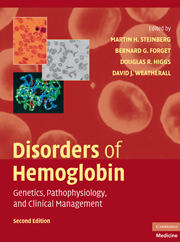Book contents
- Frontmatter
- Contents
- List of Contributors
- Foreword, by H. Franklin Bunn
- Preface
- Introduction, by David J. Weatherall
- SECTION ONE THE MOLECULAR, CELLULAR, AND GENETIC BASIS OF HEMOGLOBIN DISORDERS
- SECTION TWO PATHOPHYSIOLOGY OF HEMOGLOBIN AND ITS DISORDERS
- SECTION THREE α THALASSEMIA
- SECTION FOUR THE β THALASSEMIAS
- SECTION FIVE SICKLE CELL DISEASE
- SECTION SIX OTHER CLINICALLY IMPORTANT DISORDERS OF HEMOGLOBIN
- SECTION SEVEN SPECIAL TOPICS IN HEMOGLOBINOPATHIES
- SECTION EIGHT NEW APPROACHES TO THE TREATMENT OF HEMOGLOBINOPATHIES AND THALASSEMIA
- Index
- Plate section
SECTION TWO - PATHOPHYSIOLOGY OF HEMOGLOBIN AND ITS DISORDERS
Published online by Cambridge University Press: 03 May 2010
- Frontmatter
- Contents
- List of Contributors
- Foreword, by H. Franklin Bunn
- Preface
- Introduction, by David J. Weatherall
- SECTION ONE THE MOLECULAR, CELLULAR, AND GENETIC BASIS OF HEMOGLOBIN DISORDERS
- SECTION TWO PATHOPHYSIOLOGY OF HEMOGLOBIN AND ITS DISORDERS
- SECTION THREE α THALASSEMIA
- SECTION FOUR THE β THALASSEMIAS
- SECTION FIVE SICKLE CELL DISEASE
- SECTION SIX OTHER CLINICALLY IMPORTANT DISORDERS OF HEMOGLOBIN
- SECTION SEVEN SPECIAL TOPICS IN HEMOGLOBINOPATHIES
- SECTION EIGHT NEW APPROACHES TO THE TREATMENT OF HEMOGLOBINOPATHIES AND THALASSEMIA
- Index
- Plate section
Summary
One convenient classification of hemoglobin disorders dichotomizes these conditions into mutations that either change the primary structure of globin, called hemoglobinopathies, or reduce the expression of globin genes, called thalassemia. Rarely, a single mutation affects both the structure and expression level of the affected gene, and these have been called thalassemic hemoglobinopathies. Although at the level of the abnormal erythrocyte, many hemoglobinopathies and thalassemias can have similar pathophysiological effects, and result in similar clinical features, such generalizations do not apply to all hemoglobin disorders. For example, only sickle hemoglobin (HbS) polymerizes, triggering many features of sickle cell disease, and extreme ineffective erythropoiesis is characteristic of β thalassemia major.
The next four chapters consider how hemoglobin disorders can perturb vascular biology, the erythrocyte membrane, nitric oxide biology, and the lifespan of the affected red cell. A final chapter brings up to date the animal models that permit certain detailed study of this pathobiology. All these chapters are new to this edition.
In sickle cell disease and thalassemia, chronic hypoxia and hemolysis require vascular tone and flow adaptations. In sickle cell disease, red cell deformability is sensitive to intravascular oxygen tension as deoxygenation results in HbS polymerization, erythrocyte sickling, and vasoocclusion. Vasoocclusive events in sickle cell disease result in reperfusion injury characterized by excessive oxidant generation, endothelial activation and dysfunction, and inflammation. Similarly, in thalassemia, red cell abnormalities caused by precipitation of excess globin chains and oxidative stress lead to hemolysis and reduced red cell deformability and contribute to vascular pathobiology.
- Type
- Chapter
- Information
- Disorders of HemoglobinGenetics, Pathophysiology, and Clinical Management, pp. 137 - 138Publisher: Cambridge University PressPrint publication year: 2009



